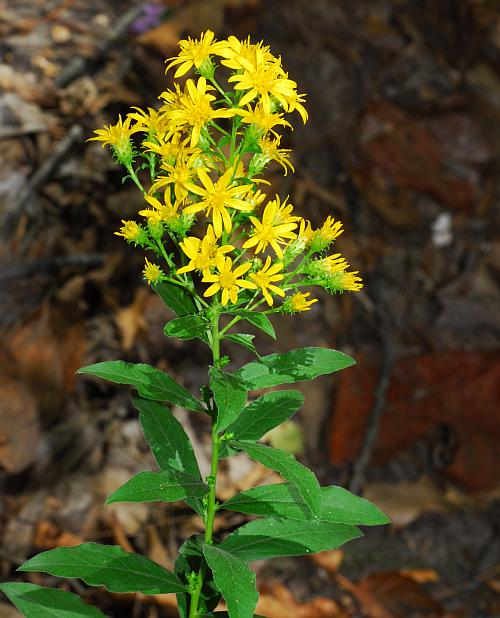Solidago petiolaris Aiton
Downy Goldenrod

Native
CC = 8
CW = 5
MOC = 61
© SRTurner
Solidago petiolaris AitonDowny Goldenrod | |
 |
Native CC = 8 CW = 5 MOC = 61 |
© SRTurner |
|
Family - Asteraceae/Astereae Habit - Perennial forb with a short and sometimes branched rootstock, occasionally producing slender rhizomes. Stems - Ascending to erect, to 1.5 m, solitary to several, finely ridged, sparsely to moderately pubescent with short, curved or occasionally stiff hairs, sometimes only sparsely hairy toward the base, not shiny, not glaucous.
Leaves - Chiefly cauline, the largest leaves in the lower 1/3 of the stem, the basal leaves absent at flowering. Basal and lowermost stem leaves with the blade 6-12 cm long, 0.5-3.5 cm wide, 3-8 times as long as wide, narrowly elliptic-oblanceolate to elliptic or obovate, relatively thick and stiff, angled or tapered to a sessile or short-petiolate base, angled or more commonly short-tapered to a sharply pointed tip, the margins hairy and entire or sparsely and shallowly toothed above the midpoint, the surfaces sometimes sticky and somewhat shiny, the upper surface glabrous or somewhat roughened, the undersurface glabrous, somewhat roughened, or sparsely to moderately pubescent with minute hairs along the main veins, with 1 main vein, the fine, pinnate secondary veins relatively easily observed (these usually forming an irregular network). Median and upper stem leaves 1-15 cm long, nearly linear to narrowly obovate, otherwise similar to the lower stem leaves.
Inflorescences - Axillary clusters grading into a narrow racemose panicle, the heads oriented in several directions when short ascending branches are present.
Heads - Involucre 4.5-7.5 mm long, the bracts in 3-5 unequal series. Involucral bracts mostly narrowly oblong-lanceolate and sharply pointed at the tip, the outermost bracts usually with the tips somewhat spreading to recurved, the thin, white to yellowish white margins hairy, the outer surface glabrous or sparsely to moderately hairy, sometimes glandular and somewhat sticky. Receptacle naked.
Florets - Ray florets 7-9, the corollas 3.5-7.5 mm long, yellow. Disc florets 10-16, the corollas 4-5 mm long, the lobes 0.9-1.8 mm long, yellow. Pappus 4.0-4.5 mm long, a few of the bristles often slightly thickened toward the tip.
Fruits - Achenes 3-4 mm long, narrowly obovoid, glabrous or nearly so at maturity. Flowering - May - November. Habitat - Glades, bluffs, dry upland forests, rocky outcrops, pastures, roadsides. Typically on acidic soils. Origin - Native to the U.S. Lookalikes - Other species of Solidago, especially S. buckleyi. Other info. - This species is moderately common in its preferred habitat in Missouri, predominantly in counties south of the Missouri River. Beyond Missouri its range extends southward through Texas and eastward through North Carolina to the Atlantic Coast. Many species of Solidago appear similar, but this one is relatively easily identified due to its recurved involucral bracts. This feature is shared by only one other Missouri goldenrod, S. buckleyi. That species has leaves with more numerous and conspicuous teeth in the margins. The usually dryish habitat and roughly cylindrical inflorescence are also good clues. Photographs taken in the Tuskegee National Forest, AL., 10-12-04 (DETenaglia); also at Little Lost Creek Conservation Area, Warren County, MO, 9-30-2011, Greensfelder Park, near Pacific, St. Louis County, MO, 9-22-2012, Caney Mountain Conservation Area, Ozark County, MO, 9-24-2017, and Glassberg Conservation Area, Jefferson County, MO, 10-5-2018 (SRTurner). |